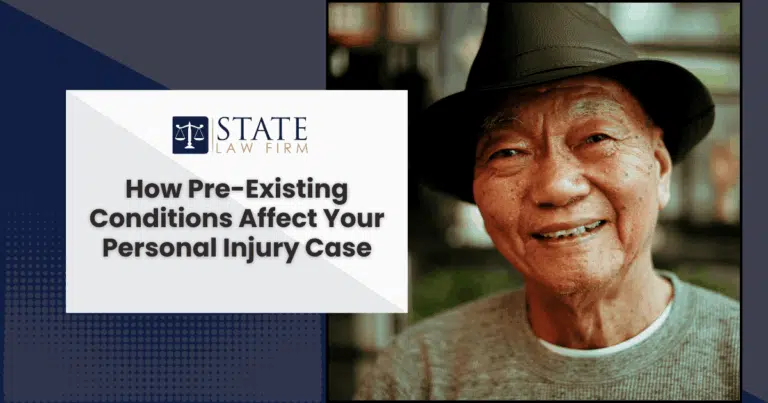When you’re injured in an accident, having a pre-existing condition can complicate your path to compensation, but it shouldn’t block it. In fact, under California law, injured victims are still entitled to recover damages even if their injuries were aggravated by a condition they already had. Understanding how the legal system handles pre-existing conditions is key to protecting your rights and maximizing your recovery.
According to the CDC, about six in ten adults in the U.S. live with a chronic disease, and four in ten have two or more, meaning the majority of injury victims may be navigating a personal injury case with some type of pre-existing health issue (CDC Chronic Disease Overview). Insurance companies often try to use this against you, reducing or denying claims by blaming your current pain or limitations on prior medical issues. That’s where experienced legal representation makes all the difference.
At State Law Firm, our team of driven young attorneys takes pride in confidently helping clients face these uphill battles. We know what it takes to push back against insurance tactics and clearly show when a new accident worsens an existing condition. Whether you’re managing an old back injury, arthritis, or any other health concern, our Sherman Oaks car accident lawyers are here to help you fight for the compensation you deserve.
In this guide, we’ll break down how pre-existing conditions affect personal injury claims, what you can do to strengthen your case, and how to deal with insurers who may try to use your medical history against you. Let’s get into it.
Understanding Pre-Existing Conditions in the Context of Personal Injury Law
A pre-existing condition is any medical issue or injury that occurred before your current accident. Common examples include chronic back pain, prior knee injuries, degenerative disc disease, or mental health disorders. In personal injury law, pre-existing conditions don’t bar recovery but make the legal strategy more nuanced.
California courts follow the “eggshell plaintiff” rule, which means defendants must take victims as they find them. If an accident worsens an existing condition, the at-fault party can still be held responsible for that aggravation. What matters most is proving that your condition was made worse by the incident in question.
At State Law Firm, we understand that life isn’t black-and-white, and neither are your medical records. Our team is equipped to highlight the real-world impact of an injury, even when insurers try to muddy the waters.
The Impact of Pre-Existing Conditions on Your Compensation Amount
Insurers often try to minimize payouts by arguing your symptoms stem from your old condition, not the new accident. But that’s not the end of the story. With the proper documentation and legal strategy, your compensation can—and should—include:
- Exacerbation of symptoms (e.g., worsened back pain or limited mobility)
- Extended treatment plans and increased medical costs
- Emotional distress from dealing with a worsened condition
- Lost income due to prolonged recovery
Pro Tip: Never accept the first settlement offer if you have a pre-existing condition. Insurers often lowball initial offers, assuming you’ll settle fast. A strong legal team can push for a settlement reflecting your damages.
Proving Causation: How to Show That Your Injury Worsened a Pre-Existing Condition
This is where medical evidence becomes crucial. To succeed in a personal injury claim involving a pre-existing condition, you’ll need to show that:
- The current accident has directly worsened your condition
- New symptoms or limitations emerged post-accident
- The aggravation has had a tangible impact on your daily life.
This is often done through before-and-after comparisons of medical records, expert testimony, and detailed narratives of how your life changed after the incident. Our team works closely with medical professionals and accident reconstruction experts to help build a compelling, fact-based argument that strengthens your position.
The Role of Medical Records and Documentation in Your Case
Your medical records tell the story and must be complete, accurate, and well-organized. Here’s what’s typically needed:
- Pre-accident medical history to establish baseline health
- Post-accident records showing new or worsened symptoms
- Doctor’s notes linking the aggravation to the incident
- Imaging reports, lab results, and physical therapy records
Pro Tip: Don’t hold back information from your attorney. Being upfront about your health history lets your legal team control the narrative, rather than allowing the insurance company to twist it.
At State Law Firm, we help clients gather, review, and present their medical documentation in a way that supports their claim, not undermines it.
Navigating Insurance Companies When You Have a Pre-Existing Condition
Insurance adjusters are trained to reduce payouts. When they see a pre-existing condition, they’ll often:
- Argue the injury wasn’t caused by the accident
- Request old records to find reasons to deny your claim.
- Delay or drag out the claims process
This is where working with a firm like ours can make a difference. We’ve handled countless cases where insurers attempted to exploit a client’s health history. By staying a step ahead and pushing back with facts, we help level the playing field and ensure clients get the compensation they need.
Final Thought
If you’re navigating a personal injury case with a pre-existing condition, don’t let that discourage you. The law is on your side—and so are we. At State Law Firm, our team is proud to take on cases that require deeper analysis and a more strategic approach. We’re here to help you present the complete picture of how this accident impacted your life and fight for your deserved compensation.
Reach out today, and let’s discuss your path to recovery with a team ready to go the extra mile.


